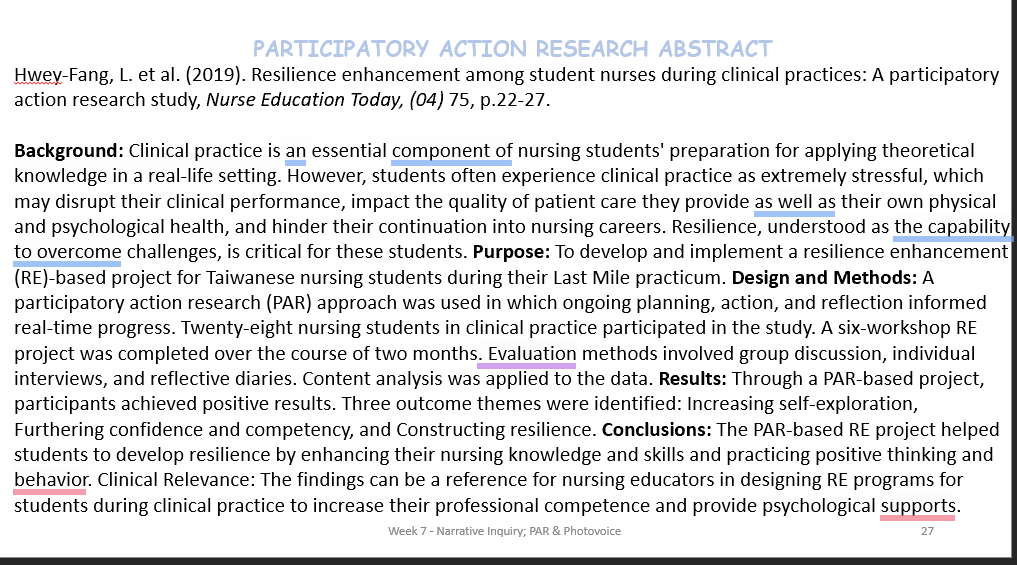W7 - narrative inquiry - participatory action research (PAR) and photovoice
1/19
There's no tags or description
Looks like no tags are added yet.
Name | Mastery | Learn | Test | Matching | Spaced |
|---|
No study sessions yet.
20 Terms
key approaches to qualitative research
qualitative traditions
phenomenology
descriptive
interpretive
grounded theory
ethnography
additional approaches (designs)
narrative inquiry
participatory action research
photovoice
the nature of narrative inquiry
researchers collect stories about their lived and told experiences
stories are heard and shaped by the researcher into a chronology
often have turning points
stories occur within a specific place or situation
narratives in health research
develop and contribute
developing and contribute to professional knwoeldge, thus can improve care
enable
professionals to understand their patients and clients more deeply by truly listening to their voices
allow
allow nursing ad other health care professionals to gain knowledge that is grounded in ‘ concrete situations’
obtained from
narrative accounts in healthcare can be obtained from patients or cleints, caregivers adn relatives ro colleagues and other professionals
best for
best for capturing detailed stories of experiences of an individual or the lives of a small number fo individuals
reasons for story telling
•Through storytelling, people have the possibility to
•give meaning to experiences, in particular suffering
•interpret and verbalize important events and share them with others
•present a holistic view of experience and perspective
•try to find adjustment when conditions are unalterable
•confirm group membership in a shared culture
•attribute blame or responsibility to themselves or others
•take more control over their own lives
dimensions of story telling
chronological or sequential
non chronological
types fo stories
everyday
cultural
autobiographical
biographical
collective
forms of narratives
restitution
chaos
quest
narrative interviewing
remembering is subjective
initial question needs to trigger a lengthy tale
control by participant
little interruption by researcher
narrative analysis
when analyzing narratives, the context of the story is important
main step
transcribing data
reducing data
restorying
analysis can be about
what is said - thematically
nature of telling the story - structural
who the story is directed to - dialogic/performance
transcription and reduction
visual analysis
participant validation
narrative analysis 2 - thematic and holistics analysis
Thematic and holistic analysis
•The narrative as a whole is analyzed.
•Main statements are identified reflecting the ‘core of the experience’
•The embedded meanings are found by focusing on the contents of the story.
•Locating the essence or the ‘core’ of the story is of great value.
•Riesman (2008) refers to this process as thematic analysis.
•The focus is on analyzing the story as a whole, focusing on ‘what’ is in the story, rather than on ‘how’ it is told
narrative analysis 2 - dialogical/performance analysis
Dialogical / performance analysis
•Like both thematic and structural analysis but focuses more on the text and the context.
•Also considers the interactive talk, gestures, mime or other elements that are part of the interaction.
•Like conversation or discourse analysis (chapter 15) because it also focuses on the people involved in the narrative and how the conversation is oriented
•Focus is on the social interaction, relationships and identities that are co-constructed with others.
•Considered a ‘hybrid’ where it takes elements of other types of analyses and combines them.
•
insider view
•Deep understanding arises of participant’s experience and perspective arises from participant’s story
•Reveals subjective truths for the participants within their social context
•Researcher and participant negotiate relationship and transactions – researchers need to continually discuss participant’s story with the participant to help shape the restory
truth in narrative research
truth and self selection
overuse and uncritical acceptance
active collaboration with participant necessary
reflection by reseacher for how they “restory”
what is participatory action research defintion
Participatory Action Research (also referred as PAR)
is a disciplined process of inquiry conducted by and for those taking the action. The primary reason for engaging in action research is to assist the “actor” in improving and/or refining his or her actions.
Often conducted with participants that are disenfranchised, who seek some emancipation.
Participatory action research (PAR) is an approach to research in communities that emphasizes participation and action. It seeks to understand the world by trying to change it, collaboratively and following reflection. PAR emphasizes collective inquiry and experimentation grounded in experience and social history.
why is PAR unique
participants as experts
participants as researchers
resaerch issues related to dependence , oppression and other inequities in need of evaluation
infroms policy
end result is action
stages
preliminary stage
all particiapnts are invovled in the proposal and part of teh reason for the project
assessment phase
ethical issues are clarified and anonymity ensured.
aims and limitations put on the table
planning phase
participants find innovative ways to solve the problem and carry out specific tasks
implementation
all participants must be comfortable with theory and practice
evaluation
observation, intervention, written reviews are used
change in cycle in par
•Researcher carefully observes what is happening in the setting. All participants should agree on their participation in the project -decision taken as a group
•Identify the problem areas they need to improve (via interview, focus groups take place)
•Implementation of change and evaluation of that change-done through several meeting, interviews and observation
research considerations
trustworthiness
extent to which the findings are accurate
PAR has two overarching goals
TO INCREASE PERSONAL AND COMMUNITY KNOWLEDGE ABOUT A TOPIC OF STUDY AND
SHOW THAT RESULTS INDICATE IMPROVEMENTS OR MOVEMENT TOWARDS DEFINED PURPOSE
example of a participatory research abstract
example

what is photovoice
“Photovoice is a method of participatory research wherein participants document their lived experience through photography, narrate their photographs, and guide data analysis through discussion with the researchers” p.125
it is used in PAR but also with the optic to explain one’s reality